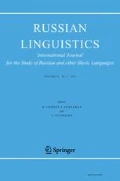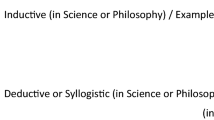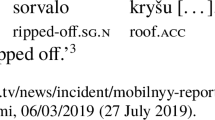Abstract
The adversity impersonal construction involves two arguments: an accusative and an instrumental. The order of these two elements is investigated with the help of 669 examples taken from a Russian corpus, and the analysis shows that the primary determinants of the word order are the pronominality of the accusative argument and the length difference between the arguments. These results are consistent with the idea that fast recognition of the sentential structure is a primary factor in sentence processing. A less influential, but still significant, variable is the animacy of the accusative—when the accusative is animate it is more prone to precede the instrumental argument. This finding shows that animacy directly affects word order in Russian.
Аннотация
В так называемой стихийной имперсональной конструкции присутствуют два структурных элемента: один в винительном падеже и другой в творительном. Порядок этих элементов рассматривается на 669 примерах из корпуса русского языка. Анализ показывает, что порядок расположения структурных элементов в русском предложении больше всего зависит от их длины и от того, является ли элемент в винительном падеже местоимением или нет. Результаты связаны с идеей о том, что самое важное при построении предложения—скорость осознания структуры предложения. Анализ также показывает, что на порядок слов оказывает влияние одушевленность: структурный элемент в винительном падеже, если он одушевленный, чаще предшествует структурному элементу в творительном падеже. Таким образом, одушевленность прямо влияет на порядок слов в русском языке.
Similar content being viewed by others
References
Abney, S. P. (1987). The English noun phrase in its sentential aspect (Doctoral dissertation, Massachusetts Institute of Technology). Retrieved from http://www.vinartus.com/spa/87a.pdf (26 March 2014).
Arnold, J. E., Losongco, A., Wasow, T., & Ginstrom, R. (2000). Heaviness vs. newness: the effects of structural complexity and discourse status on constituent ordering. Language, 76(1), 28–55.
Baayen, R. H. (2008). Analyzing linguistic data. A practical introduction to statistics using R. Cambridge.
Baayen, R. H. (2011). LanguageR. R package. Retrieved from http://cran.r-project.org/src/contrib/Archive/languageR/ (26 March 2014).
Babby, L. (1994). A theta-theoretic analysis of adversity impersonal sentences in Russian. In S. Avrutin, S. Franks & L. Progovac (Eds.), Formal Approaches to Slavic Linguistics (FASL-2). The MIT meeting 1993 (Michigan Slavic Materials, 36, pp. 25–67). Ann Arbor.
Bartoń, K. (2012). MuMIn: Multi-model inference. R package version 1.7.2. Retrieved from http://CRAN.R-project.org/package=MuMIn (26 March 2014).
Bates, D., Maechler, M., & Bolker, B. (2011). lme4: Linear mixed-effects models using S4 classes. R package version 0.999375-42. Retrieved from http://CRAN.R-project.org/package=lme4 (26 March 2014).
Branigan, H. P., Pickering, M. J., & Tanaka, M. (2008). Contributions of animacy to grammatical function assignment and word order during production. Lingua, 118, 172–189.
Bresnan, J., Cueni, A., Nikitina, T., & Baayen, R. H. (2007). Predicting the dative alternation. In G. Bouma, I. Krämer & J. Zwarts (Eds.), Cognitive foundations of interpretation (pp. 69–94). Amsterdam.
Coyle, J. M., & Kaschak, M. P. (2012). Female fertility affects men’s linguistic choices. PLoS ONE, 7(2), e27971. doi:10.1371/journal.pone.0027971.
De Cuypere, L., & Verbeke, S. (2013). Dative alternation in Indian English: a corpus-based analysis. World Englishes, 32(2), 169–184.
Gibson, E. (1998). Linguistic complexity: locality of syntactic dependencies. Cognition, 68, 1–76.
Green, M. C. (1980). On the syntax and semantics of impersonal sentences in Russian: a study of the sentence type: “Vetrom uneslo lodky”. Ann Arbor.
Gries, S. T. (2003). Multifactorial analysis in corpus linguistics. A study of particle placement. London, New York.
Hawkins, J. A. (1994). A performance theory of order and constituency (Cambridge Studies in Linguistics, 73). Cambridge.
Hawkins, J. A. (2004). Efficiency and complexity in grammars. Oxford.
Kizach, J. (2010). The function of word order in Russian, compared to English and Danish (Unpublished doctoral dissertation). University of Aarhus, Aarhus.
Kizach, J. (2012). Evidence for weight effects in Russian. Russian Linguistics, 36(3), 251–270.
Kizach, J., & Balling, L. W. (2013). Givenness, complexity and the Danish dative alternation. Memory and Cognition, 41(8), 1159–1171. doi:10.3758/s13421-013-0336-3.
Lohse, B., Hawkins, J. A., & Wasow, T. (2004). Domain minimization in English verb-particle constructions. Language, 80(2), 238–261.
Mustajoki, A., & Kopotev, M. V. (2005). Lodku uneslo vetrom: uslovija i konteksty upotreblenija russkoj ‘stixijnoj’ konstrukcii. Russian Linguistics, 29(1), 1–38.
Rosenbach, A. (2005). Animacy versus weight as determinants of grammatical variation in English. Language, 81(3), 613–644. doi:10.1353/lan.2005.0149.
Royall, R. M. (1986). The effect of sample size on the meaning of significance tests. The American Statistician, 40(4), 313–315.
Seoane, E. (2009). Syntactic complexity, discourse status and animacy as determinants of grammatical variation in Modern English. English Language and Linguistics, 13(3), 365–384. doi:10.1017/S1360674309990153.
Smith, M. B. (1994). Agreement and iconicity in Russian impersonal constructions. Cognitive Linguistics, 5(1), 5–56.
Szmrecsányi, B. M. (2004). On operationalizing syntactic complexity. In G. Purnelle, C. Fairon & A. Dister (Eds.), Le poids des mots. Actes des 7es Journées internationales d’Analyse Statistique des Données Textuelles (JADT 2004, vol. 2, pp. 1031–1038). Louvain-la-Neuve.
The R Development Core Team (2011). R: a language and environment for statistical computing. R Foundation for Statistical Computing. Vienna. http://www.R-project.org.
Wagenmakers, E.-J., & Farrell, S. (2004). AIC model selection using Akaike weights. Psychonomic Bulletin & Review, 11(1), 192–196.
Wasow, T. (1997). Remarks on grammatical weight. Language Variation and Change, 9, 81–105.
Wiechmann, D., & Lohmann, A. (2013). Modeling domain minimization. PP order revisited. Language Variation and Change, 25, 1–24.
Author information
Authors and Affiliations
Corresponding author
Additional information
The work was financed by the Danish Council for Independent Research. The author wishes to thank Arto Mustajoki for providing the data, Michael Krabbe Borregaard for advice on the statistics and Galina Starikova for language assistance.
Rights and permissions
About this article
Cite this article
Kizach, J. A multifactorial analysis of the Russian adversity impersonal construction. Russ Linguist 38, 205–211 (2014). https://doi.org/10.1007/s11185-014-9128-z
Published:
Issue Date:
DOI: https://doi.org/10.1007/s11185-014-9128-z




